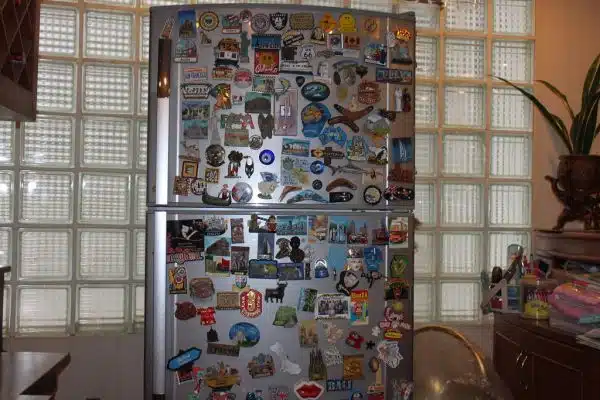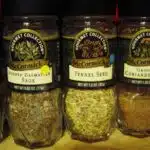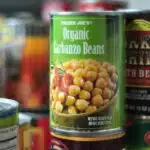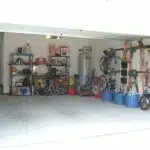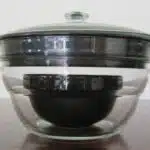As a food storage and organization specialist, I have seen firsthand how an organized fridge can make meal prep more efficient and enjoyable. A well-organized fridge not only saves time and money but also ensures that your food stays fresh for longer periods. With busy schedules, it’s easy to fall into the trap of grabbing fast food or ordering takeout. However, with some planning and organization, you can easily prepare nutritious meals at home.
The key to successful meal prep is creating a system that works for you. Whether you’re a beginner or an experienced meal prepper, organizing your fridge can help streamline your process. In this article, we’ll explore the best practices for organizing your fridge to optimize your meal prep routine. We’ll cover everything from proper food storage techniques to utilizing space effectively. By implementing these tips, you’ll be able to create healthy and delicious meals in no time.
Assessing Your Current Fridge Setup
When it comes to meal prepping, having a well-organized fridge is essential to ensure your food stays fresh and lasts the week. Before diving into organizing your fridge, it’s important to assess your current setup. One of the first things you should consider is the size of your fridge. If you have a smaller fridge, you may need to be more creative with how you store your food. On the other hand, if you have a larger fridge, you may have more space to work with but also more areas that can become cluttered.
Another aspect to consider when assessing your current fridge setup is evaluating your storage needs. Take a look at the types of food you typically prepare for meal prep and what containers they come in. This will help determine what types of storage containers or organizers you may need in order to maximize space and keep everything organized. Additionally, take note of any areas in your fridge that tend to become overcrowded or disorganized which can lead to wasted food and money.
In summary, before diving into organizing your fridge for meal prep it’s important to assess its size and evaluate your storage needs. This will allow you to make informed decisions when purchasing any necessary organizers or containers while maximizing space within your fridge. Once you’ve completed this step, it’s time to move onto clearing out and cleaning up your fridge which we’ll explore further in the next section.
Clearing Out And Cleaning Your Fridge
Deep cleaning your fridge is an essential step in meal prep organization. Start by removing all the food items from your fridge, and then discard any expired or spoiled products. Use warm soapy water to clean the shelves, walls, and drawers of your fridge thoroughly. Make sure you rinse off all the soap residue before putting back the food items.
Donating excess food items can help reduce waste and provide for those in need. Before meal prepping, go through your pantry and fridge to check for any excess food items that you won’t be using anytime soon. Consider donating them to a local food bank or charity organization instead of letting them go to waste.
Creating a fridge inventory and meal prep list can help you stay organized and save time during meal prep. Write down all the ingredients you have on hand, including their expiration dates, on a list. This way, you can quickly see what needs to be used up first before it goes bad. Creating a meal prep list will also help you plan ahead of time, so you know exactly what ingredients are needed for each recipe.
To continue organizing your fridge for meal prep purposes, grouping similar foods together is another crucial step. Keep dairy products together in one area of the fridge while vegetables should be stored together in another area. This way, when it’s time to prepare meals, everything is easily accessible and ready for use without having to search through your entire fridge.
Grouping Similar Foods Together
Grouping similar foods together is an excellent way to keep your fridge organized and save time during meal prep. This strategy involves grouping foods based on their similarities, such as proteins, vegetables, fruits, and dairy products. By doing so, you can quickly identify what ingredients you need for a particular recipe and avoid wasting time searching through the fridge.
Meal prep benefits greatly from this grouping strategy for different diets. For example, if you are following a low-carb or keto diet, you can group high-protein foods such as chicken breast, fish fillets, and eggs together in one section of the fridge. Likewise, if you are following a vegan or vegetarian diet, you can group plant-based protein sources like tofu and tempeh with other vegetables for easy access during meal prep.
To make the most of this grouping strategy, consider the following tips:
- Use clear storage containers to store prepped ingredients.
- Keep frequently used items at eye level for easy reach.
- Arrange items in order of use to streamline your meal prep process.
By using this strategy and these tips, you can create an organized fridge that supports your healthy eating habits and makes meal prep a breeze. In the next section, we will discuss how labeling and dating your food can further improve your organization system.
Labeling And Dating Your Food
Ah, the joys of rummaging through a fridge trying to figure out what’s edible and what isn’t. It’s like a treasure hunt, only instead of gold doubloons, we have expired yogurt and wilted greens. But fear not! As a food storage and organization specialist, I’m here to tell you that there is a solution to this problem – labeling and dating your food.
The benefits of labeling your food are many. First and foremost, it helps you keep track of what you have in stock. By writing down the contents of each container or bag, you can easily identify what needs to be used up quickly or what can wait until later. Additionally, labeling can help avoid confusion when other family members or roommates are also using the fridge. No more guessing if that Tupperware belongs to you or your partner!
Another benefit of labeling is reducing food waste. How many times have you thrown away leftovers because you couldn’t remember when you made them? By adding a date to your labels, you’ll know exactly how long something has been sitting in the fridge and whether it’s still safe to eat. This will save both money on groceries and reduce your environmental impact by cutting down on food waste.
Investing in organizational tools such as containers with built-in labels or magnetic whiteboards for the fridge door can make labeling even easier. These tools not only help keep things tidy but also serve as visual reminders of what needs to be eaten first. So go ahead, take control of your fridge using these simple yet effective techniques – label and date your food today!
Investing In Organizational Tools
Benefits of utilizing organizational tools for fridge are immense. Firstly, they help in reducing food waste by keeping the perishable items in plain sight and preventing them from getting lost in the back of the fridge. Secondly, these tools provide easy access to food items that can be used for meal prep, saving time and effort. Thirdly, organizing tools such as bins or baskets improve hygiene by keeping spills contained and limiting cross-contamination.
There are various types of organizational tools for a fridge that one can invest in. Clear containers are great for storing leftovers and meal prepped food as they allow you to see what’s inside without having to open them. Lazy Susans fit perfectly on shelves and can be used to store condiments or jars, making it easy to find what you need without having to move everything around. Fridge mats or liners help keep shelves clean by catching spills and drips.
Investing in organizational tools is a wise decision if you want to make your life easier when it comes to meal prep. Not only will it save you time and energy but it will also reduce stress while cooking by providing an organized space where everything has its place. In the next section, we will discuss how using clear containers can be a helpful tool for organizing your fridge even further.
Using Clear Containers To See What You Have
Investing in organizational tools is essential when it comes to meal prepping. However, it’s not just about purchasing the right tools; it’s also about utilizing them effectively. Clear containers are a must-have for anyone looking to organize their fridge for meal prep.
Clear container benefits are numerous. Firstly, they allow you to see exactly what you have in your fridge without having to open every container. This makes meal planning and prepping much more efficient as you can quickly identify what ingredients you need and what you already have on hand. Secondly, clear containers make it easier to keep track of expiration dates, ensuring that food doesn’t go to waste. Finally, they help maintain the quality of your food by keeping it fresh for longer periods.
When it comes to choosing the best clear container options, there are a few things to consider. It’s important to choose containers that are durable and leak-proof as this will prevent spills and keep your fridge clean. Look for containers that come in different sizes and shapes so that you can easily store a variety of foods. Additionally, consider investing in stackable containers as this will help save space in your fridge.
By utilizing clear containers effectively, you can ensure that your meal prep process is streamlined and stress-free. But don’t forget about your freezer! Utilizing your freezer for meal prep is another great way to save time and money while still enjoying healthy meals throughout the week.
Utilizing Your Freezer For Meal Prep
Freezing techniques are a great way to extend the life of your meal prep recipes. Freezing meals for later use can save you time, money and effort in the long run. By utilizing your freezer effectively, you can keep your meal prep organized and efficient.
One freezing technique is to freeze fruits and vegetables. This method is ideal for those who want to have fresh produce on hand all year round. Simply wash and dry the produce, then cut it into bite-size pieces before placing it in a freezer-safe container or bag. For best results, make sure to remove as much air as possible from the container or bag before freezing.
Another freezing technique is to portion out your meals into individual servings before freezing them. This makes it easier to defrost only what you need when you’re ready to eat. You can also label each container with the date and contents so that you know exactly what’s inside.
Overall, utilizing your freezer effectively can help you save time and money in your meal prep routine. By following these simple freezing techniques, you can ensure that your meals are always fresh and delicious.
Next up: storing raw meat and fish safely…
Storing Raw Meat And Fish Safely
When it comes to storing raw meat and fish safely, it is important to choose the right container that is leak-proof, airtight, and easy to clean.
It is also important to ensure that meat and fish are safely defrosted, either in the refrigerator or in cold water.
Temperature control is key to storing raw meat and fish safely; storing them at temperatures below 40°F is recommended by the U.S. Department of Agriculture.
A thermometer should be used to regularly check the temperature of the refrigerator, and the food should be stored in the coldest part of the fridge.
Raw meat and fish should be stored separately from other foods, preferably in the bottom shelf of the fridge, to avoid cross-contamination.
Raw meat and fish should be cooked within two days of purchase and must not be refrozen once thawed.
Choosing The Right Container
When it comes to meal prep, storing raw meat and fish safely is essential. Choosing the right container is crucial in ensuring that these items remain fresh and free from contamination. As a food storage and organization specialist, I recommend choosing durable containers that are specifically designed for storing raw meat and fish.
Durable containers are essential when it comes to storing raw meat and fish safely. They should be made from materials that can withstand extreme temperatures and prevent leaks or spills. Glass containers with tight-fitting lids are an excellent option as they are easy to clean, eco-friendly, and reusable. Plastic containers with airtight seals can also be used but make sure they are BPA-free and microwave-safe.
For those who are environmentally conscious, there are eco-friendly container options available. These include glass containers with bamboo lids, silicone bags, stainless steel containers, and beeswax wraps. These options not only help reduce plastic waste but also provide a sustainable way of storing food. When choosing eco-friendly containers, make sure they meet the standards required for storing raw meat and fish safely.
In summary, choosing the right container plays a significant role in storing raw meat and fish safely for meal prep. Durable containers made from glass or BPA-free plastic with tight-fitting lids are excellent options to consider. For those looking for more eco-friendly alternatives, glass containers with bamboo lids, silicone bags, stainless steel containers, or beeswax wraps can also be used as long as they meet safety standards. By choosing the right container for your meal prep needs, you can ensure that your food remains fresh and safe to eat throughout the week.
Defrosting Meat And Fish
When it comes to meal prep, storing raw meat and fish safely is crucial. However, before storing them in containers, it’s essential to thaw them first. Thawing techniques vary depending on the type of meat or fish, but safe defrosting practices are necessary to avoid contamination.
One of the safest ways to defrost meat and fish is by placing them in the refrigerator overnight. This method allows the food to thaw slowly, preventing any bacteria growth that could occur when using other methods such as hot water or microwave. If you’re short on time, placing the frozen item in a sealed plastic bag and submerging it in cold water can also work but make sure to change the water every 30 minutes until fully thawed.
It’s essential to follow safe defrosting practices when preparing your meals for meal prep. By using these methods, you can ensure that your raw meat and fish remain free from contamination while still being fresh for consumption throughout the week.
Managing Temperatures
Proper temperature management is essential when storing raw meat and fish. It’s important to keep these items at a consistent temperature to prevent bacterial growth and ensure their freshness. One of the best ways to achieve this is by adjusting settings on your refrigerator or freezer to maintain the desired temperature for meat and fish storage.
Temperature control devices can also be utilized to manage the temperature of your meat and fish. These devices help maintain a consistent temperature, ensuring that your food stays fresh for longer periods. By using a digital thermometer, you can monitor the internal temperature of your meat and fish, making sure it remains within safe limits.
It’s crucial to follow proper temperature management practices when storing raw meat and fish. Ensuring that they’re kept at the correct temperature will not only prevent contamination but also extend their shelf life. By properly utilizing your refrigerator/freezer settings and using temperature control devices, you can be confident in the safety and quality of your stored meats and fish.
Keeping Produce Fresh With Proper Storage
Did you know that 40% of fruits and vegetables in the United States go uneaten? One of the main reasons for this is improper storage. Properly storing produce not only prevents waste but also helps preserve their nutritional value and flavor. Here are some tips on how to keep your produce fresh with proper storage.
First, consider using DIY produce bags. These can be made out of materials such as cotton mesh or muslin and are a great alternative to plastic bags. Not only are they eco-friendly, but they also allow for better air circulation which helps prevent moisture buildup that can lead to spoilage. Additionally, DIY produce bags can be reused multiple times, making them a cost-effective solution.
Next, it’s important to store your produce at the best refrigerator temperature. The ideal temperature range for most fruits and vegetables is between 35-40°F (1-4°C). However, some fruits such as apples and pears should be stored at slightly higher temperatures around 40-45°F (4-7°C). It’s important to note that storing produce too cold can cause damage as well, so make sure to avoid setting your refrigerator temperature below 32°F (0°C).
By following these tips, you’ll ensure that your produce stays fresh for longer periods of time. In the next section, we’ll discuss how to create a snack station in your fridge for easy access to healthy snacks throughout the day.
Creating A Snack Station
When meal prepping, creating a designated snack station in your fridge can not only save you time but also make it easier to grab healthy options throughout the day. The key to a successful snack station is having a variety of choices readily available and easily accessible. This is especially important when catering to children who may need kid-friendly choices.
To start, designate one or two shelves in your fridge for snacks only. Make sure these shelves are at eye level and easy to access. Consider using clear containers or bins to store items such as cut-up fruits and veggies, yogurt cups, and hummus dip. This will not only keep your fridge organized but also allow you to see exactly what snacks you have available.
When organizing your snack station, keep in mind that less is more when it comes to minimal clutter. Avoid overcrowding the designated shelves with too many items as this can make it difficult to find what you’re looking for and cause frustration. Instead, focus on having a variety of healthy options that cater to both adults and children alike.
In order to maximize shelf space within your designated snack station, consider using stackable bins or containers. These can be easily labeled with different categories such as ‘fruits’, ‘veggies’, or ‘dairy’. By keeping similar items together, it will be easier for you and your family members to quickly find what they’re looking for without having to search through multiple containers or bags. Next up, we’ll discuss some tips on how to utilize stackable bins throughout your entire fridge for ultimate organization!
Maximizing Shelf Space With Stackable Bins
Now that we have a designated area for snacks, let’s move on to organizing the rest of the fridge for meal prep. One effective way to do this is by using different bin sizes and shapes for specific food items. For instance, you can use clear containers with lids for prepped veggies or fruits, making them easily accessible when it’s time to cook. Meanwhile, you can use deeper containers for meat or poultry products to prevent cross-contamination.
While stackable bins are great for maximizing shelf space, there are other alternatives you can try as well. For example, lazy susans are perfect for storing condiments and sauces that tend to get pushed to the back of the fridge. You can also install sliding drawers to make it easier to reach items at the back without having to remove everything in front of them.
By arranging items by frequency of use, you’ll be able to access your ingredients quickly without having to rummage through everything in the fridge. Start by placing everyday essentials like milk or yogurt on eye-level shelves. Then move on to less frequently used items like leftovers or specialty ingredients on lower shelves or towards the back of the fridge. By doing this, you’ll save time and energy during meal prep while keeping your fridge organized and clutter-free.
Arranging Items By Frequency Of Use
Frequency tracking is an essential aspect of organizing a fridge for meal prep. It involves arranging items based on how often they are used. This strategy ensures that frequently used items are within easy reach, while rarely used ones are placed in the back or at the bottom of the fridge. By doing so, you can save time and avoid the hassle of rummaging through your fridge looking for ingredients.
When arranging your fridge by frequency of use, it is crucial to consider what you use most often. For example, if you usually prepare breakfast smoothies every morning, your blender and frozen fruits should be stored in a visible and accessible location. Similarly, if you tend to cook meat or fish regularly, ensure that these items are stored in an area with consistent temperature to maintain freshness.
The time-saving benefits of organizing your fridge by frequency of use cannot be overemphasized. By keeping frequently used items at arm’s length, you can reduce meal prep time significantly. Furthermore, this strategy can help minimize food waste as it allows you to keep track of perishable items such as vegetables and fruits that need to be consumed before they spoil. In the next section, we’ll discuss how making a meal plan and prepping ahead can further streamline your meal prep routine and help you achieve your health goals effortlessly.
Making A Meal Plan And Prepping Ahead
Arranging food items by frequency of use is vital for an organized fridge. It helps save time and effort during meal prep as the most frequently used ingredients are easily accessible. With a well-organized fridge, it’s easier to maintain a healthy diet, reduce food waste and save money.
Meal prep benefits go beyond just having healthy meals readily available. It also saves time and money by reducing the need to eat out or order takeout regularly. Budget-friendly meal prep ideas include buying in bulk, using seasonal produce, and planning meals around sales and deals at the grocery store.
Using leftovers for future meals is a great way to minimize food waste and make meal prep even more efficient. Before tossing any uneaten food, consider if it can be incorporated into a future meal. Leftover roasted veggies can be added to salads or stir-fries while leftover chicken can be used in sandwiches or wraps. By getting creative with leftovers, you can create new dishes without spending extra time or money on additional ingredients.
Using Leftovers For Future Meals
- Leftovers can be used to create new meals and snacks while reducing food waste.
- Meal prep strategies are an effective way to make use of leftovers and plan ahead for future meals.
- To maximize the use of leftovers, it is important to store them in airtight containers and date them for future use.
- Refrigeration and freezing are the most common methods for storing leftovers.
- Reusing leftovers can be accomplished by transforming them into new dishes and incorporating them into other meals.
- When meal prepping with leftovers, it is important to ensure food safety by checking the temperature of the food and ensuring it is properly reheated.
Using Leftovers
In order to reduce food waste and stretch ingredients, using leftovers for future meals is a great strategy. As a food storage and organization specialist, I highly recommend incorporating this practice into your meal prep routine. Not only does it save time and money, but it also allows for creative recipes that utilize what you already have on hand.
One way to use leftovers is to repurpose them into new meals. For example, leftover roasted vegetables can be added to omelets or soups, and roasted chicken can be shredded and used in tacos or salads. Another option is to simply reheat the leftovers and serve them as-is for a quick lunch or dinner. This not only saves time but also ensures that the food does not go to waste.
When organizing your fridge for meal prep, it’s important to designate a specific area for leftovers. Label containers with the date they were prepared and make sure they are stored properly to maintain quality and freshness. By incorporating leftover usage into your meal planning, you’ll not only reduce food waste but also open up new possibilities for creative recipes that stretch ingredients further.
Meal Prep Strategies
Meal prep is a crucial aspect of any kitchen routine. It allows for efficient use of time, reduces food waste, and enables the creation of healthy and delicious meals throughout the week. However, meal prep strategies can sometimes be challenging to implement, especially when it comes to using leftovers for future meals. As a food storage and organization specialist, I have encountered several benefits and challenges in incorporating meal prep strategies into leftover usage.
The benefits of meal prep strategies for using leftovers are numerous. Firstly, it saves time by reducing the amount of cooking required during the week. By preparing a few key ingredients in advance and utilizing leftovers creatively, you can significantly cut down on cooking time without sacrificing variety or nutrition. Secondly, it helps reduce food waste by ensuring that all ingredients are used up before they go bad. Finally, meal prep encourages healthier eating habits by making it easier to plan out balanced meals ahead of time.
However, challenges may arise when trying to incorporate meal prep strategies into leftover usage. One common obstacle is figuring out how to repurpose leftovers into new meals without becoming repetitive or boring. Another challenge is determining how much food to prepare in advance based on your family’s needs and preferences while still ensuring that there are enough leftovers for future meals. Lastly, storage can be an issue if containers are not properly labeled or organized in the fridge or freezer.
In conclusion, incorporating meal prep strategies into leftover usage is a great way to save time and reduce food waste while creating delicious and nutritious meals throughout the week. While there may be some challenges along the way such as determining portion sizes or avoiding repetition in recipes, with proper planning and organization these obstacles can easily be overcome. By taking advantage of this strategy, you’ll not only save money but also enjoy more flavorful and diverse meals throughout the week!
Reusing Leftovers
When it comes to saving time and reducing food waste in the kitchen, using leftovers for future meals is an excellent strategy. However, reusing leftovers can become repetitive or boring if not approached creatively. As a food storage and organization specialist, I recommend incorporating creative recipes that repurpose leftovers into new and exciting dishes.
One way to reuse leftovers is by transforming them into soups or stews. For example, leftover roasted vegetables can be blended with broth to create a flavorful pureed soup. Similarly, leftover chicken or beef can be added to a pot of chili for extra protein and flavor. Another way to repurpose leftovers is by incorporating them into breakfast dishes such as omelets or frittatas. Leftover vegetables, meats, or grains can be mixed with eggs and cheese for a quick and satisfying morning meal.
To avoid repetition when reusing leftovers, it’s essential to plan ahead and incorporate variety into your meal prep strategy. One approach is to divide larger portions of leftovers into smaller containers and freeze them for future use. This allows for greater flexibility when planning meals throughout the week while also reducing food waste. Additionally, incorporating new spices or sauces can help transform leftovers into new culinary experiences.
In summary, reusing leftovers can be a creative way to save time and reduce food waste in the kitchen. By incorporating creative recipes such as soups or stews and planning ahead for variety, you can enjoy delicious meals throughout the week while minimizing your environmental impact.
Maintaining Your Organized Fridge Over Time
As a food storage and organization specialist, it’s important to acknowledge that maintaining an organized fridge can be a daunting task. After all, life is busy, and sometimes taking the time to ensure your fridge remains streamlined can feel like just another chore. However, by creating a maintenance schedule and sticking to it, preventing clutter buildup can become second nature.
Firstly, set aside 10-15 minutes each week to evaluate what needs to be done in terms of fridge organization. This could include checking expiration dates, reorganizing items that have been moved around during the week or wiping down any spills or messes. By making this a weekly habit, you’ll avoid having to dedicate hours on end to cleaning out your fridge every few months.
Secondly, take some time each month to deep clean your fridge – remove all items from shelves and drawers and give everything a thorough wipe down. Use this opportunity to assess what items you’re not using and what may have gone bad without being noticed. This will help prevent clutter buildup over time and keep your fridge looking its best.
Remember that maintaining an organized fridge is an ongoing process. By creating a maintenance schedule and making small tweaks as needed along the way, you’ll be able to save time and energy in the long run while keeping your fridge in tip-top shape for meal prep and beyond.
Conclusion
Proper organization of your fridge can make meal prep and cooking a breeze. By assessing your current fridge setup, clearing out and cleaning your fridge, grouping similar foods together, labeling and dating your food, investing in organizational tools, arranging items by frequency of use, making a meal plan and prepping ahead, using leftovers for future meals, and maintaining your organized fridge over time, you can create an efficient system that saves you time and money.
Investing in organizational tools such as clear bins, labels, and shelf dividers can enhance the organization of your fridge. With these tools in place, you can easily locate ingredients while cooking or packing meals. While maintaining the organization of your fridge may seem daunting at first, it is worth the effort in terms of saving time and reducing food waste. Overall, organizing your fridge for meal prep is a valuable skill to have as it provides a sense of ease when it comes to cooking healthy meals on a regular basis.
In conclusion, organizing your fridge for meal prep is crucial for anyone looking to save time and reduce food waste. By following the steps outlined above and investing in organizational tools that suit your needs best – whether they be clear bins or labels – you’ll be able to keep everything tidy whilst remaining practical. Remember: creating an efficient system takes some effort but once established it will lead to long term benefits!
Image Credits
- “Organized fridge- Tamanna” by nist6ss (featured)

